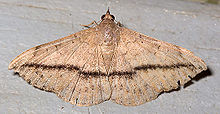Anticarsia gemmatalis
| Anticarsia gemmatalis | |
|---|---|

| |
| Scientific classification | |
| Kingdom: | |
| Phylum: | |
| Class: | |
| Order: | |
| Family: | |
| Subfamily: | |
| Tribe: | |
| Genus: | |
| Species: | A. gemmatalis
|
| Binomial name | |
| Anticarsia gemmatalis Hübner, 1818
| |
| Synonyms | |
| |
Anticarsia gemmatalis is a tropical species of caterpillar and moth that migrates north each season. The species can commonly be found in the Gulf states, north as far as Wisconsin. The adults have wings that are grayish brown, crossed with brown or black zigzag lines. The caterpillars are black or green, with narrow lighter stripes on the back and sides. They spit out a brownish substance, spring into the air and wriggle a lot when they are disturbed. The species eats velvet beans, peanut, soybeans, cotton, kudzu, alfalfa, cowpeas, horse beans, snap beans, lima beans, and coffeeweeds. Its common name is velvetbean caterpillar[1] and velvetbean moth.[2]
Egg viability was highest at 25 °C (77 °F) and adaptation to higher temperatures did not occur over a three generation observation. This suggests global warming will reduce A. gemmatalis losses on soybeans in tropical areas that are already at 25 °C (77 °F) but increase predation on soybeans in areas currently below that temperature, thus in actual fact only shifting the affected area.[3]
References
- ^ The Common Insects Of North America by Lester A. Swan and Charles S. Papp, 1972, page 282-283
- ^ ZipCode Zoo Archived May 27, 2012, at the Wayback Machine
- ^ da Silva, D.M.; Hoffmann-Campo, C.B.; de Freitas Bueno, A.; de Freitas Bueno, R.C.O.; de Oliveira, M.C.N.; Moscardi, F. (2011-11-24). "Biological characteristics of Anticarsia gemmatalis (Lepidoptera: Noctuidae) for three consecutive generations under different temperatures: understanding the possible impact of global warming on a soybean pest". Bulletin of Entomological Research. 102 (3). Cambridge University Press (CUP): 285–292. doi:10.1017/s0007485311000642. ISSN 0007-4853.
External links
- Velvetbean caterpillar on the University of Florida / Institute of Food and Agricultural Sciences Featured
Creatures website
- "Species Anticarsia gemmatalis - Velvetbean Caterpillar Moth - Hodges#8574". Bug Guide. Retrieved 2020-11-07.
- "Anticarsia gemmatalis (soybean caterpillar)". CABI Invasive Species Compendium. 2019-11-24. Retrieved 2020-11-07.
- "velvetbean caterpillar, Anticarsia gemmatalis Lepidoptera: Erebidae". Invasive.Org. Retrieved 2020-11-07.
